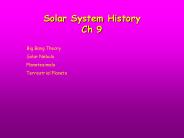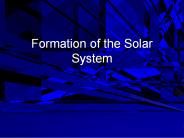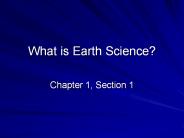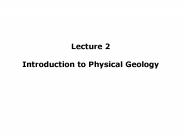Nebular PowerPoint PPT Presentations
All Time
Recommended
to model the observations. Found since to work across all galaxies Ciardullo (03) ... for PNLF bright end in elliptical ( 10Gyr) galaxies? Possible explanations...
| PowerPoint PPT presentation | free to view
NEBULAR HYPOTHESIS
| PowerPoint PPT presentation | free to download
Globular Clusters (M13 in Hercules, M22 in Sagittarius) Extragalactic nebulae ... Harlow Shapley: Spiral Nebulae within the Milky Way. ...
| PowerPoint PPT presentation | free to download
hydrodynamical calculations: large sets now becoming available. Perinotto ... Still to be included: full hydrodynamics, non-sphericity, binary progenitors, etc. ...
| PowerPoint PPT presentation | free to download
Good probes of stellar populations ... Absolute probes of stellar ... Intra-cluster (IC) PNs as probes of the IC starlight. PN morphology and stellar pops ...
| PowerPoint PPT presentation | free to download
The Nebular Theory, Matter, and Light Terrestrial, Jovian, and dwarf planets Nebular theory Matter atoms and molecules Kinetic and potential energy
| PowerPoint PPT presentation | free to download
Term 'planetary nebula' coined by Herschel to describe faint, disk appearance ... falls directly to ground state, Lyman photon of sufficient energy to ionize ...
| PowerPoint PPT presentation | free to view
or at least the ejection process is strongly influenced by ... Hydra spectrograph, 2002-04. Dispersion 0.33 A/pix; resolution ~7500. RV precision ~3-3.7 km/s ...
| PowerPoint PPT presentation | free to download
Balmer lines of Hydrogen. Transitions are to ... C = speed of light. V = radial velocity. ?0 ... Use of Doppler Effect to find Planets. Discover planets ...
| PowerPoint PPT presentation | free to download
A round or axisymmetric shape, sometimes with multiple shells or outer haloes. ... Silkworm. NGC 6302. Hb 5. Size does matter! 28. 28. A necessary question...
| PowerPoint PPT presentation | free to view
Pilyugin et. al (2003, A&A, 401, 557) find O/H = 8.52 dex in the solar vicinity ... was formed, there has been an 0.13 dex increase in oxygen abundance of the ISM ...
| PowerPoint PPT presentation | free to view
C and O galactic gradients I: observational values from ORLs ... are dwarf star from Ackerman 2004. are H II regions from Paper I ...
| PowerPoint PPT presentation | free to view
Totally weird. 39. Irregular. 3. Slow variations. 3. Eclipse. 3. Slow decline ... W-7405-Eng-48, the National Science Foundation through the Center for Particle ...
| PowerPoint PPT presentation | free to download
SOFIA teletalk: R. Sahai/JPL * ...
| PowerPoint PPT presentation | free to view
Physical conditions in shocked regions of ... Credit: NASA, ESA,HEIC, and the Hubble Heritage Team (STScI/AURA) ... A. Riera (UPC), P. Garc a-Lario (ESA) & ESA ...
| PowerPoint PPT presentation | free to download
Miriam Pe a - Grazyna Stasinska - Slawomir G rny ... VZ 94 Van de Steen & Zijlstra 1994. Phillips: Phillips 2002. CKS: Cahn, Kaler & Stanghellini 1992 ...
| PowerPoint PPT presentation | free to download
... is predicted to have low surface brightness signatures in the visible and near infrared. ... 6853, the resulting Lya brightness is much higher, due to the ...
| PowerPoint PPT presentation | free to download
The Origin of Our Solar System II Major Physical Processes in Solar Nebular Theory Heating Protosun Sun -In-falling materials converts gravitational energy into ...
| PowerPoint PPT presentation | free to view
Bringing E.T. into Your Classroom The Search for Extra solar Planets Gary Lawhon Dave Baltenberger Nebular theory of solar system formation would lead us to believe ...
| PowerPoint PPT presentation | free to view
Origin of Our Solar System TEK Objective 5: Earth in space and time. The student understands the solar nebular accretionary disk model. The student is expected to ...
| PowerPoint PPT presentation | free to view
Formation of the Solar System Solar System Formation of the Solar System preview of the big bang theory the interstellar medium nebular condensation theories what s ...
| PowerPoint PPT presentation | free to download
How do stars form? The Nebular Hypothesis Observations Stars can be seen in various stages of formation. Stars seem to have been forming continuously since the ...
| PowerPoint PPT presentation | free to download
'DIOGEN'- A New Computing Tool For The Diagnostics. And Chemical Analysis Of Nebular Plasma. ... A 4-zone nebular shell model is used to derive Ne and Te ...
| PowerPoint PPT presentation | free to download
Warm Up 9/13 What is the study of the atmosphere and the processes that produce weather and climate? Meteorology According to the nebular hypothesis, our solar system ...
| PowerPoint PPT presentation | free to download
Differentiated bodies. We see evidence for planet-forming nebular disks around stars ... waves in disk probably caused by interaction with planets ...
| PowerPoint PPT presentation | free to download
... Royal Astronomy in 1791, with the title 'On Nebulous Stars, Properly So Called ' ... to the conclusion that planetary nebulae were nebulous material around a star. ...
| PowerPoint PPT presentation | free to download
Formation of protostar and protostellar nebula. Evolution of early sequences and ... Protostar starts sucking in nearby nebular gases, forms local increase in ...
| PowerPoint PPT presentation | free to download
The Solar System How was it formed The Nebular Theory Started as nebula about 5 billion years ago Composed of hydrogen and helium Nearby supernova sent shock waves ...
| PowerPoint PPT presentation | free to view
Newton finds force of gravity is what moves planets toward the sun. ... Brightening sun clears away nebular gas. Composition. Solar Nebula. 98.4 % gas (H, He) ...
| PowerPoint PPT presentation | free to view
Why is it so difficult to detect planets around other stars? ... Discovery of 'hot Jupiters' has forced reexamination of nebular theory ' ...
| PowerPoint PPT presentation | free to view
Modern Nebular Hypothesis. New stars in Milky Way: 98% H and He ... Mantle - Mg and Si rich rock (plastic - 67% of Earth's mass) Outer core - molten S, Fe, Ni ...
| PowerPoint PPT presentation | free to view
Intro to the Solar System I. How did the solar system form? A. First, the sun formed from its nebula. 1. Refer to nebular theory and for more details.
| PowerPoint PPT presentation | free to download
Intro to the Solar System I. How did the solar system form? A. First, the sun formed from its nebula. 1. Refer to nebular theory and for more details.
| PowerPoint PPT presentation | free to download
These patterns are far more important and interesting than numbers, names, ... The discovery of 'hot Jupiters' has forced a reexamination of nebular theory. ...
| PowerPoint PPT presentation | free to view
An Introduction to the Solar System: An Overview. Scale Models. A. Sizes of ... All lie near the ecliptic. Origin of the Solar System . Nebular Hypothesis. m ...
| PowerPoint PPT presentation | free to view
Intro to the Solar System I. How did the solar system form? A. First, the sun formed from its nebula. 1. Refer to nebular theory and for more details.
| PowerPoint PPT presentation | free to download
In a Coronal (or Nebular) plasma, collisions excite ions but are too rare to de ... Yes, and this can be calculated after modeling a plasma. ...
| PowerPoint PPT presentation | free to download
Narrow-band HeII ( 4684) & off-HeII ( 4751) imaging surveys allow W-R stars to ... IZw18 includes both HeII 4686 narrow nebular (Campbell et al. 1986) and broad ...
| PowerPoint PPT presentation | free to download
What can emission lines tell us? lecture 1 Gra yna Stasi ska
| PowerPoint PPT presentation | free to view
Solar System History Ch 9 Big Bang Theory Solar Nebula Planetesimals Terrestrial Planets Big Bang Hypothesis 13-14 billion years ago, all matter and energy was ...
| PowerPoint PPT presentation | free to download
Chapter 8 Welcome to the Solar System
| PowerPoint PPT presentation | free to download
Chapter 8 Formation of the Solar System
| PowerPoint PPT presentation | free to download
The Solar System formed from a cloud of hot gas and dust known as the Solar Nebula ... As the nebula cooled, the matter in the disk condensed and the planets formed. ...
| PowerPoint PPT presentation | free to view
Geologic Time and Origins of the Earth Thinking about time Geologic time vs. normal time What is the date today? What is the day? What is the time?
| PowerPoint PPT presentation | free to view
... but are warmed by that visible light and so radiate in the IR visible light image IR light image mosaic IR stars in Orion IR star DC303.8-14.2 visible light ...
| PowerPoint PPT presentation | free to view
What the UV SED Can Tell Us About Primitive Galaxies Sally Heap NASA s Goddard Space Flight Center
| PowerPoint PPT presentation | free to download
Formation of the Solar System ... * The big bang spread matter throughout the expanding universe. Some of this matter gathered into clouds of dust and gas.
| PowerPoint PPT presentation | free to download
What is Earth Science? Chapter 1, Section 1 Overview of Earth Science Earth science is the name for the group of sciences that deals with Earth and its neighbors in ...
| PowerPoint PPT presentation | free to download
Yeah I got the game I got it off ebay. Did you clean my shoes. Yeah with my new shoe buffer ... And the car civil shields are on in every state. Deleted scene ...
| PowerPoint PPT presentation | free to view
Modelling the Red Halos of Blue Compact Galaxies Zackrisson, E1., Bergvall, N1., Marquart, T1., Mattsson, L1. & stlin, G.2 1 Uppsala Astronomical Observatory ...
| PowerPoint PPT presentation | free to download
Touring Our Solar System Chapter 23 The Planets: An Overview 23.1 The Solar System The terrestrial planets are planets that are small and rocky Mercury, Venus ...
| PowerPoint PPT presentation | free to view
What is a Planet? Physical Geology (1) A 'planet'1 is a celestial body that (a) is in orbit around the Sun, (b) has ... body forces so that it assumes a ...
| PowerPoint PPT presentation | free to download
Formation of the Solar System and Other Planetary Systems * * Astronomical Jargon asteroid asteroid belt average density chemical composition comet dynamo escape ...
| PowerPoint PPT presentation | free to download
Formation of the Solar System
| PowerPoint PPT presentation | free to download
Title: Testing Author: Mark Voit Last modified by: Michael Brotherton Created Date: 9/29/1999 2:52:42 PM Document presentation format: On-screen Show (4:3)
| PowerPoint PPT presentation | free to download
The Solar System A journey through our neighboring planets
| PowerPoint PPT presentation | free to download
























































